You’ve probably noticed how South Dakota’s unpredictable weather can turn your gardening dreams into nightmares, with scorching summers hitting 100°F and brutal winters plunging to -20°F. Most imported plants simply can’t handle these extreme swings, leaving you with dead landscapes and wasted money. However, native species have spent thousands of years adapting to these harsh conditions, developing remarkable survival strategies that’ll transform your approach to gardening forever.
Contents
- 1 South Dakota’s Diverse Climate Challenges
- 2 Prairie Wildflowers for Gardens
- 3 Drought-Tolerant Native Trees
- 4 Hardy Native Shrubs for Landscaping
- 5 Selecting the Right Native Plants for Your Garden
- 6 Frequently Asked Questions
- 6.1 Where Can I Purchase Native South Dakota Plants Locally?
- 6.2 When Is the Best Time to Plant Native Species in South Dakota?
- 6.3 How Do I Prepare Soil for Native South Dakota Plants?
- 6.4 Do Native Plants Require Fertilizer or Special Soil Amendments?
- 6.5 How Long Does It Take for Native Plants to Establish?
South Dakota’s Diverse Climate Challenges
While most states deal with one or two hardiness zones, South Dakota throws gardeners a curveball with four distinct USDA zones ranging from 4a to 5b. You’ll face winter lows from -35°F in northern counties to -15°F south of Interstate 90, creating serious plant hardiness challenges across the state.
Your garden must survive temperature swings exceeding 50°F between seasons. Cities like Sioux Falls sit in Zone 4b, while Spearfish enjoys milder Zone 5a conditions. This means you can’t rely on your neighbor’s plant recommendations if they’re counties away.
Climate resilience becomes essential when selecting native species for long-term success. Beyond temperature, factors like winter sunshine, humidity levels, and wind exposure will determine which plants actually thrive in your specific location.
Prairie Wildflowers for Gardens
South Dakota’s native prairie wildflowers offer gardeners stunning blooms, pollinator support, and drought tolerance, ranging from showy displays to rare specimens perfectly adapted for local conditions. These resilient species provide educational opportunities for gardeners interested in learning about regional plant ecology and conservation practices.
Purple Prairie Clover

Purple Prairie Clover is a striking native perennial that brings vibrant color and ecological value to South Dakota gardens. Growing 1-3 feet tall, this legume produces distinctive cone-shaped flower heads with bright purple-rose blooms that open progressively from bottom to top throughout July and August. Its delicate pinnately compound foliage and numerous slender stems create an airy texture in the landscape.
This drought-tolerant wildflower develops an extensive root system with a taproot reaching up to 6 feet deep, making it exceptionally resilient once established. As a nitrogen-fixing legume, it enriches soil while providing nectar for native bees, honey bees, and butterflies. Purple Prairie Clover works beautifully in mixed perennial borders, prairie gardens, and short grass meadows, offering deer resistance and excellent cut flower potential. The plant is frequently included in prairie restoration mixes due to its ecological benefits and ability to establish in challenging conditions.
- Hardiness: Cold hardy, suitable for South Dakota climate zones
- Light: Full sun
- Water: Dry to mesic; drought tolerant once established
- Soil: Well-drained, sometimes calcareous soils preferred
- Fertilizer: None needed; fixes nitrogen naturally
- Pest/Disease Resistance: Deer resistant with good overall resistance
- Growth Rate: Moderate establishment; long-lived once mature
Black-Eyed Susan
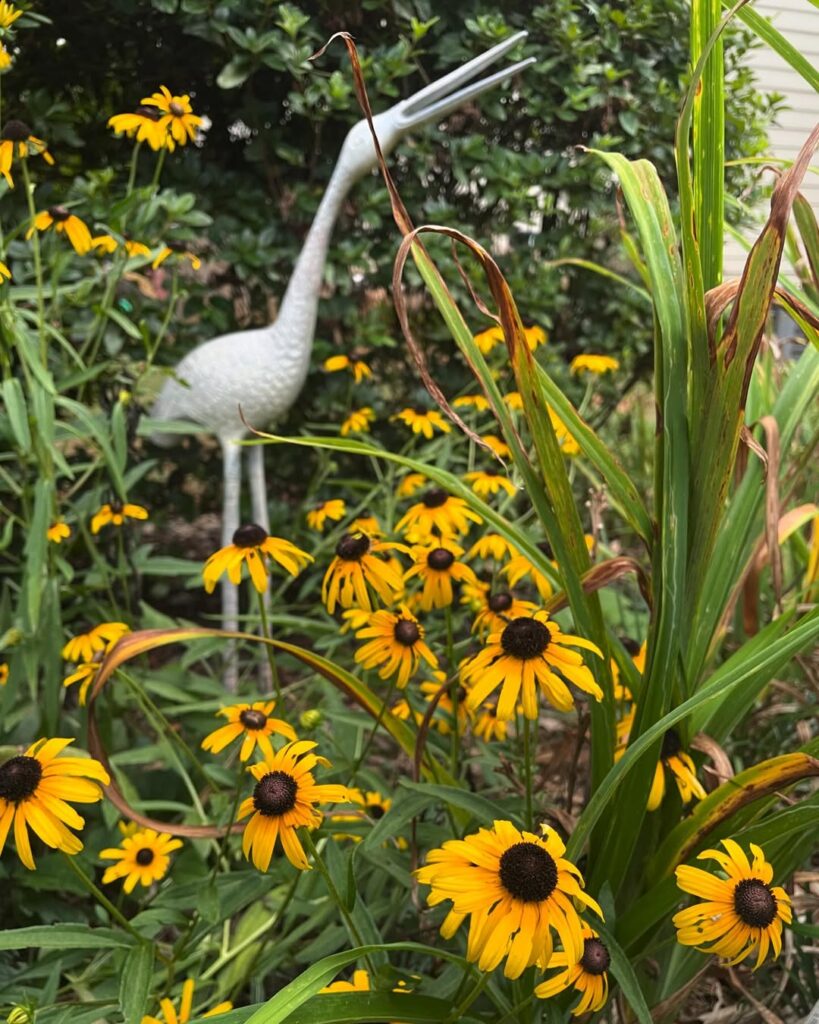
Black-Eyed Susan (Rudbeckia hirta) is a resilient native wildflower that brings vibrant yellow-orange blooms to South Dakota gardens. This biennial species produces distinctive 2-3 inch flower heads with bright ray petals surrounding dark brown central cones. Growing 12-40 inches tall, it thrives in challenging conditions and serves as an excellent pioneer species for naturalizing areas.
As a warm-season forb, Black-Eyed Susan blooms from summer through fall, typically peaking in July and August. Its drought tolerance and adaptability to various soil types make it ideal for low-maintenance prairie gardens, where it provides reliable color and supports local ecosystems while requiring minimal care once established. The plant produces small black quadrangular achenes that are 1.5-2 mm long, making seed collection convenient for gardeners looking to propagate this native species.
- Hardiness: USDA zones 3-9, native to South Dakota climate
- Light: Full sun to partial shade
- Water: Low to moderate; drought tolerant once established
- Soil: Clayey loam to sandy loam; adaptable to various soil types
- Fertilizer: Minimal requirements; thrives in average to poor soils
- Pest/Disease Resistance: Generally resistant with few serious issues
- Growth Rate: Moderate to fast; pioneer species that quickly colonizes areas
Wild Bergamot

Wild bergamot is a vibrant prairie wildflower native to South Dakota, belonging to the mint family. This adaptable perennial produces clusters of lavender to pink tubular flowers from June through September, making it an excellent choice for prairie gardens and naturalized landscapes. Also known as bee balm, it spreads naturally through underground rhizomes and thrives in the state’s diverse growing conditions.
As a true prairie native, wild bergamot demonstrates remarkable versatility in garden settings. It performs well in both formal garden beds and wild meadow plantings, tolerating a wide range of soil conditions while providing essential habitat for pollinators. Its heat tolerance and drought resistance make it particularly valuable for sustainable landscaping in South Dakota’s climate. The fragrant foliage has historically been used for making tea and seasoning, while the colorful flowers are also edible.
- Hardiness: Native to South Dakota; cold hardy throughout the state
- Light: Full sun to light shade
- Water: Medium drought tolerance; adapts to both dry and moist conditions
- Soil: Well-drained preferred; tolerates acidic to alkaline soils (pH <6.8 to >7.2)
- Fertilizer: Low maintenance; typically does not require supplemental feeding
- Pest/Disease Resistance: Good resistance; may develop mildew without proper air circulation
- Growth Rate: Moderate; spreads readily via rhizomes once established
Pasque Flower
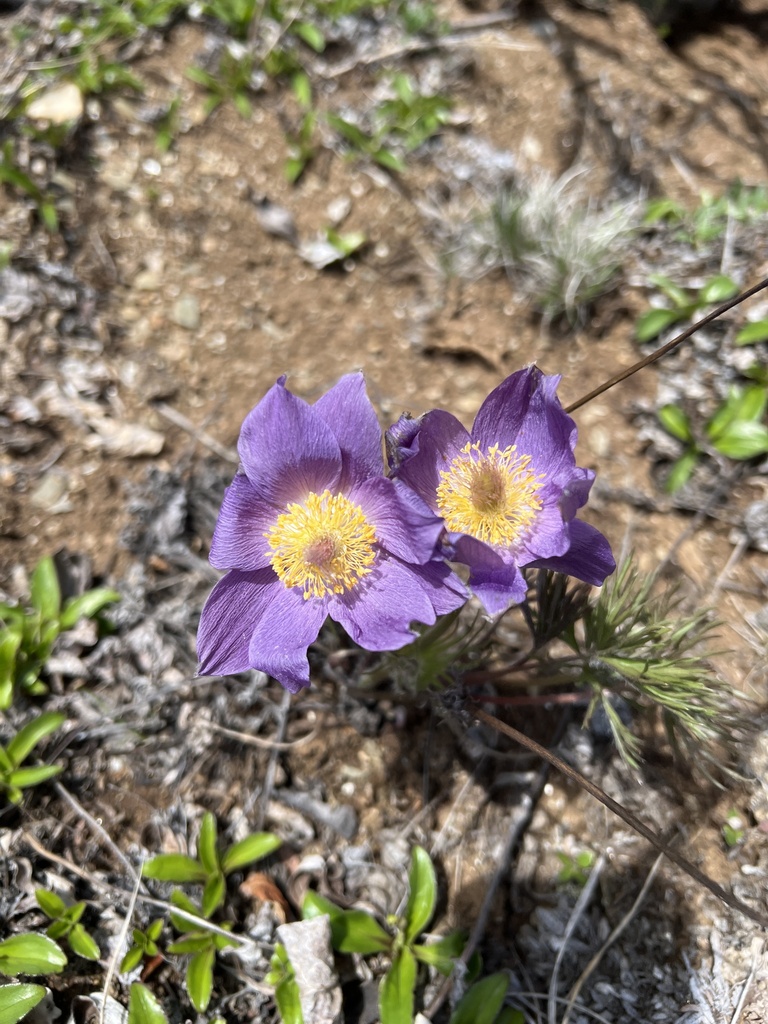
The pasque flower stands as South Dakota’s beloved state flower, earning its designation in 1903 as one of the prairie’s most cherished wildflowers. This hardy perennial emerges as among the first blooms of spring, sometimes pushing through lingering snow with its distinctive bell-shaped flowers in shades of blue, lavender, and purple. Standing 8-17 inches tall, the entire plant is covered in distinctive silky hairs that give it a soft, silvery appearance in sunlight.
After blooming, the flowers transform into equally attractive seed heads resembling shaggy balls of silky threads. The deeply lobed, finely dissected foliage typically appears after the flowers fade. Beyond its ornamental value, this native wildflower serves as a vital early nectar source for spring pollinators and holds significant cultural importance, having been used medicinally by Indigenous peoples despite its toxicity. All plant parts contain toxic compounds that make the entire plant poisonous to humans and livestock.
- Hardiness: Zones 3-6, extremely cold tolerant prairie perennial
- Light: Full sun, thrives in open, exposed locations
- Water: Low to moderate water needs, drought tolerant once established
- Soil: Well-drained soils, tolerates poor prairie conditions
- Fertilizer: None required, adapted to natural prairie nutrients
- Pest/Disease Resistance: Excellent resistance, very few pest or disease issues
- Growth Rate: Slow to establish, long-lived once mature
Wild Prairie Rose

The wild prairie rose is a resilient native subshrub that grows 1-3 feet tall throughout South Dakota’s roadsides and pastures. This hardy plant features beautiful pink flowers with five broad, wavy-edged petals surrounding bright yellow stamens, blooming primarily in July. Despite dying back each winter, it reliably returns each spring, making it an excellent choice for native plant gardens.
As South Dakota’s state flower since 1907, the wild prairie rose adds natural beauty to landscape designs while supporting local biodiversity. The flowers, measuring 1½ to 2 inches across, form in clusters of 1-4 blooms on smooth stalks, providing striking contrast against the plant’s thorny, reddish stems and green foliage. The stems are covered with reddish thorns that help the plant climb over other vegetation.
- Hardiness: Very hardy, dies back in winter but returns reliably each spring
- Light: Full sun to partial sun
- Water: Low water requirements, prefers dry conditions
- Soil: Well-draining soil, tolerates poor soils, often found along gravel roads
- Fertilizer: No fertilizer needed, thrives in native conditions
- Pest/Disease Resistance: Excellent resistance, very low maintenance
- Growth Rate: Moderate, reaches 1-3 feet tall with 7-inch flower stems
Drought-Tolerant Native Trees
South Dakota’s native trees offer exceptional drought tolerance while providing essential shade, windbreak protection, and wildlife habitat across diverse soil conditions and challenging prairie climates. These trees reduce the need for supplemental irrigation and help maintain beautiful landscapes even during dry periods.
Eastern Red Cedar

The Eastern Red Cedar (Juniperus virginiana) is actually a native juniper tree that serves as one of South Dakota’s most adaptable evergreen species. This medium-sized conifer typically reaches 30-40 feet tall with aromatic, scale-like foliage that ranges from gray-green to blue-green. Known historically as the “Tree of Life” by Native Americans, it features distinctive reddish-brown bark and produces pale blue seed cones on female plants.
Extremely hardy and drought-tolerant, Eastern Red Cedar thrives in South Dakota’s challenging climate conditions. Its exceptional resistance to heat, cold, and drought makes it invaluable as a windbreak tree across the state’s plains and prairie regions. The species also provides important wildlife habitat while effectively controlling erosion, though it can spread naturally in grasslands and may sometimes be considered invasive in native prairie ecosystems. The tree creates dense shade that can significantly reduce the productivity of surrounding pasture and rangeland areas.
- Hardiness: USDA zones 3-7
- Light: Full sun to partial shade
- Water: Low to moderate; extremely drought-tolerant once established
- Soil: Adaptable to various soil types; tolerates poor, rocky, and alkaline soils
- Fertilizer: Generally none needed; thrives in nutrient-poor conditions
- Pest/Disease Resistance: Very good; may host cedar-apple rust affecting nearby apple trees
- Growth Rate: Slow to moderate
American Basswood Tree

American Basswood is a majestic native deciduous tree that can reach heights of 75-130 feet with a broad, rounded crown. Known as the “Bee-tree” for its fragrant flowers that attract pollinators, this long-lived species produces heart-shaped leaves and develops distinctive furrowed gray bark. The tree offers excellent shade and serves multiple purposes, from urban landscaping to wildlife habitat, while its soft wood has been utilized for various crafts and construction needs throughout history. In South Dakota, American Basswood is found primarily in the eastern part of the state where it naturally occurs within its native range.
- Hardiness: Zones 2-8, can live over 200 years
- Light: Partial shade to full sun, shade-tolerant but less so than sugar maple
- Water: Moderate water needs, suitable for riparian plantings
- Soil: Adaptable to various soil types, tolerates different conditions
- Fertilizer: Low maintenance, typically doesn’t require supplemental fertilization
- Pest/Disease Resistance: Generally resistant with good overall health
- Growth Rate: Fast-growing compared to other northern hardwood species
Bur Oak

Bur oak stands as one of South Dakota’s most resilient native trees, perfectly adapted to the state’s challenging climate extremes. This deciduous oak develops thick, leathery leaves and corky bark that provide exceptional protection against prairie winds, fire, frost, and hail damage.
With unmatched drought tolerance among North American oaks, bur oak thrives where annual precipitation is minimal. Its deep taproot system, reaching 4.5 feet in the first year alone, allows it to access water unavailable to competing vegetation. The tree forms a broad, rounded crown with glossy lobed leaves that turn attractive coppery-bronze in fall, making it both functional and ornamental for South Dakota landscapes. This remarkable native can reach 80 feet tall at maturity with an equally impressive spread, creating substantial shade for generations to come.
- Hardiness: Extremely cold-tolerant, exceeds all other North American oak species
- Light: Full sun
- Water: Very drought-tolerant once established, requires minimal supplemental watering
- Soil: Adapts to various soil conditions including very acidic soils, well-draining preferred
- Fertilizer: Generally not required, thrives in native soil conditions
- Pest/Disease Resistance: Excellent resistance due to thick bark and hardy nature
- Growth Rate: Moderate, 1-2 feet per year on favorable sites once established
Green Ash Tree
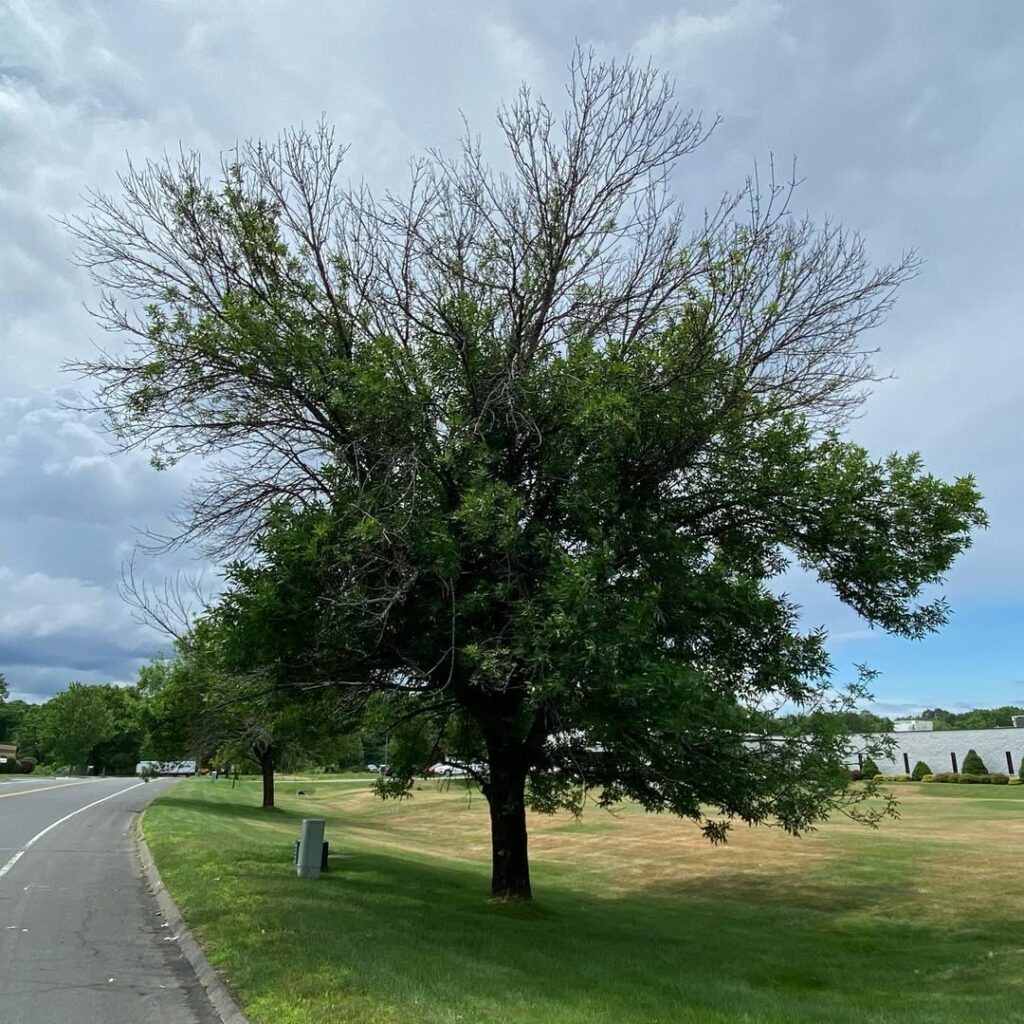
The Green Ash is South Dakota’s most widespread native ash tree, naturally occurring along rivers, streams, and wooded draws throughout the state. This medium-sized deciduous tree grows 50-70 feet tall with distinctive compound leaves featuring 5-7 leaflets and attractive diamond-patterned bark. Young trees display a pyramidal form that matures into a rounded crown with irregular branching.
As a dioecious species, male and female flowers appear on separate trees in early spring, followed by single-winged samaras on female trees that provide important wildlife food. The deep-green summer foliage transforms to brilliant yellow in fall, adding seasonal interest to landscapes while supporting local ecosystems.
Green Ash thrives in diverse habitats from floodplains and riverbanks to mesic woodlands and open fields. This adaptability makes it an excellent choice for various landscape situations across South Dakota’s changing terrain conditions.
- Hardiness: USDA zones 3-9, extremely hardy to climatic extremes
- Light: Full sun to partial shade
- Water: Moderate to low water needs once established, drought-tolerant
- Soil: Adapts to various soil conditions, prefers moist bottomland but tolerates drier sites
- Fertilizer: Low fertilizer requirements, thrives in native soils
- Pest/Disease Resistance: Susceptible to emerald ash borer and ash yellows disease
- Growth Rate: Fast-growing hardwood species
Paper Birch
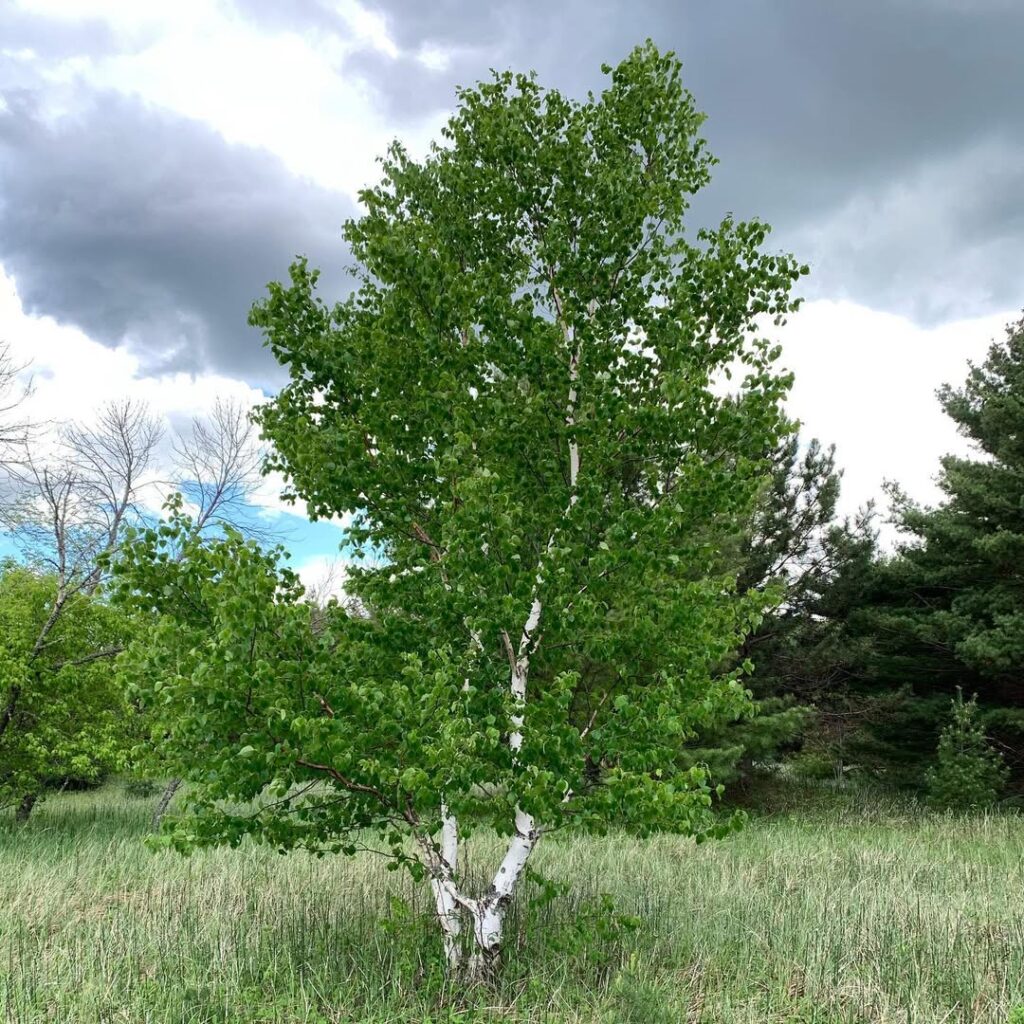
Paper birch is a distinctive deciduous tree native to South Dakota’s northern regions, recognizable by its characteristic white, peeling bark. This fast-growing pioneer species typically reaches 65-98 feet at maturity and serves as an early colonizer of disturbed areas like burned or cleared land. While moderately drought-tolerant, it performs best with consistent moisture and full sunlight, making it unsuitable for heavily shaded locations.
The species provides significant ecological value, supporting diverse wildlife from moose and deer to various bird species. Its nutrient-rich leaf litter enhances soil fertility, while yellow-bellied sapsuckers tap its bark for sap. Culturally important to Indigenous peoples for canoe construction and crafts, paper birch also serves modern uses in timber products and birch syrup production.
- Hardiness: Very cold hardy, thrives in zones with long winters and short cool summers
- Light: Full sun required; highly shade intolerant for mature growth
- Water: Prefers consistent soil moisture; moderate drought tolerance but suffers in prolonged dry periods
- Soil: Adaptable to acidic, loamy, sandy, well-drained, and clay soils; prefers moist, well-drained conditions
- Fertilizer: Low maintenance; contributes to soil fertility through nutrient-rich leaf litter
- Pest/Disease Resistance: Susceptible to stress from compacted soils and extended high temperatures
- Growth Rate: Rapid growth in early life, among first trees to establish in open areas
Hardy Native Shrubs for Landscaping
South Dakota’s hardy native shrubs offer drought tolerance, wildlife habitat support, and low-maintenance landscaping solutions while providing year-round beauty and ecological benefits for residential properties. These native species require less maintenance than non-native alternatives, making them ideal choices for sustainable landscape design.
Serviceberry (Juneberry)

Serviceberry, also known as Saskatoon or juneberry (Amelanchier alnifolia), is a versatile native shrub perfectly suited for South Dakota landscapes. This hardy member of the rose family typically grows 1-5 meters tall and produces beautiful white spring flowers followed by dark purple berries in late June. Its natural suckering habit and adaptability to various soil conditions make it an excellent choice for naturalized prairie settings.
Beyond its ornamental value with striking fall colors ranging from yellow to red, serviceberry offers edible fruit that can be enjoyed fresh or processed into jams, jellies, and pies. The plant’s reddish-brown seeds are quite small at only 3-4 mm long, making propagation straightforward for gardeners interested in growing from seed. Available in both standard and dwarf varieties, it serves dual purposes as both an attractive landscape plant and a productive food source, making it ideal for sustainable, ecologically appropriate gardening.
- Hardiness: USDA Zone 3, extremely cold tolerant for South Dakota climate
- Light: Full sun to partial shade, adaptable to various light conditions
- Water: Drought tolerant once established, may grow taller in consistently moist sites
- Soil: Adaptable to wide range of soil types, prairie hillside conditions preferred
- Fertilizer: Low maintenance, typically does not require supplemental fertilization
- Pest/Disease Resistance: Generally pest and disease resistant as a native species
- Growth Rate: Moderate growth rate with suckering habit forming colonies over time
American Hazelnut Shrub
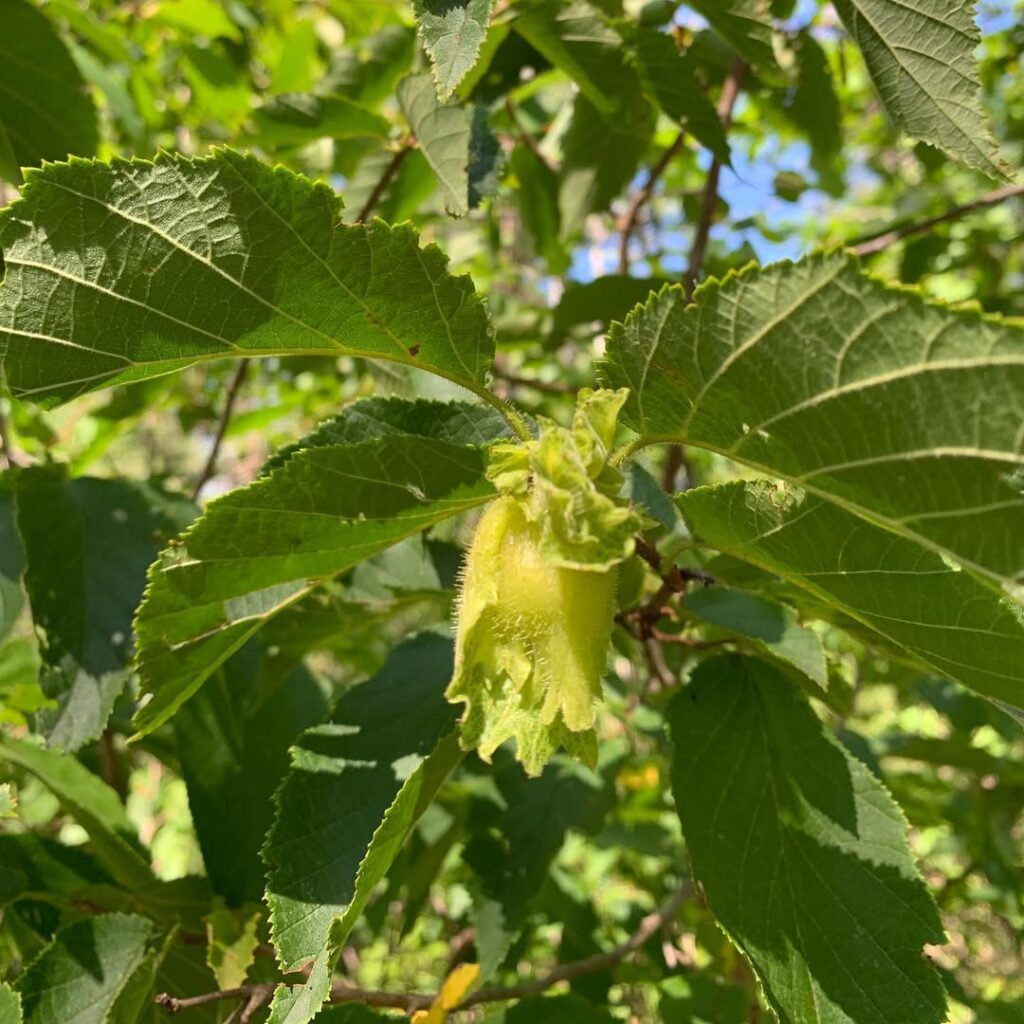
The American Hazelnut is a deciduous, multi-stem shrub native to eastern and central North America, including South Dakota. Growing 6-12 feet tall, this hardy shrub forms dense, mound-shaped colonies through basal suckering, making it ideal for naturalistic landscaping and wildlife gardens. Its fuzzy stems bear simple, alternate leaves that turn brilliant yellow to wine-red in autumn.
This versatile shrub produces edible hazelnuts enclosed in distinctive leafy husks and serves as an excellent early spring pollen source. The unisexual flowers appear as yellowish-brown catkins before leaf emergence, followed by nuts that mature from July to September. Its thicket-forming habit provides valuable wildlife cover and nesting sites while offering food for birds, squirrels, and other mammals. The nuts are rich in unsaturated fats and provide essential proteins, vitamins, and minerals for both wildlife and human consumption.
- Hardiness: USDA zones 4b and above, cold-hardy for South Dakota winters
- Light: Full sun to deep shade; highly adaptable to various light conditions
- Water: Moist to moderately dry conditions; tolerates drought and brief flooding
- Soil: Well-drained to moderately moist soils; thrives in rich, diverse soil types
- Fertilizer: Minimal requirements; thrives in native soil conditions without supplemental feeding
- Pest/Disease Resistance: Generally resistant with few significant pest or disease issues
- Growth Rate: Moderate to fast; spreads readily through vegetative suckering
Chokecherry Shrub
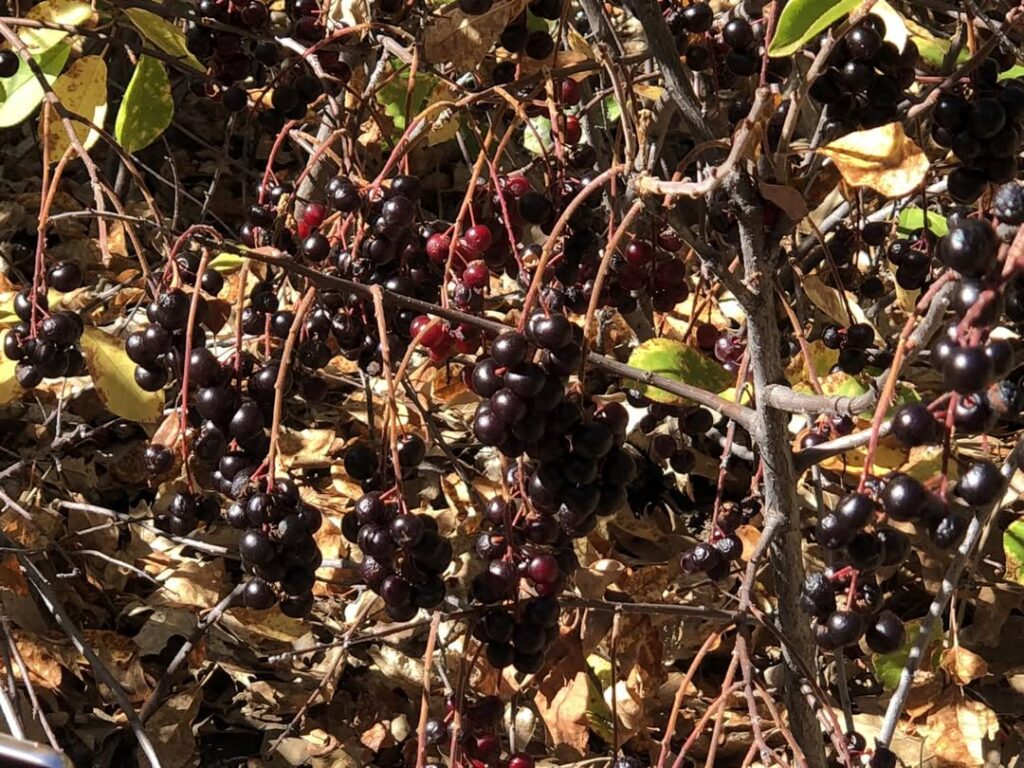
The chokecherry is a versatile deciduous shrub or small tree that serves as an excellent choice for South Dakota landscapes. Growing 10-25 feet tall with a dense, irregular crown, it produces fragrant white spring flowers followed by dark purple to black berries that attract diverse wildlife. Its thicket-forming habit and extensive root system make it valuable for erosion control and windbreaks.
This hardy native adapts well to various soil conditions and sites, from woodland edges to disturbed areas. The attractive seasonal interest includes spring blooms, summer foliage, and vibrant fall colors ranging from yellow to orange-red. The small round sour fruit is particularly valued for making preserves and wine. Cultivars like ‘Canada Red’ offer unique purple foliage for enhanced ornamental appeal.
- Hardiness: Zones 2-7, extremely cold hardy
- Light: Full sun preferred, tolerates moderate shade
- Water: Drought tolerant once established, adaptable to wet or dry conditions
- Soil: Adaptable to wide range of soil types and textures, pH tolerant
- Fertilizer: Low maintenance, typically requires no supplemental fertilization
- Pest/Disease Resistance: Generally resistant, some susceptibility to tent caterpillars and black knot fungus
- Growth Rate: Moderate to fast, spreads via rhizomes
Sumac Shrub
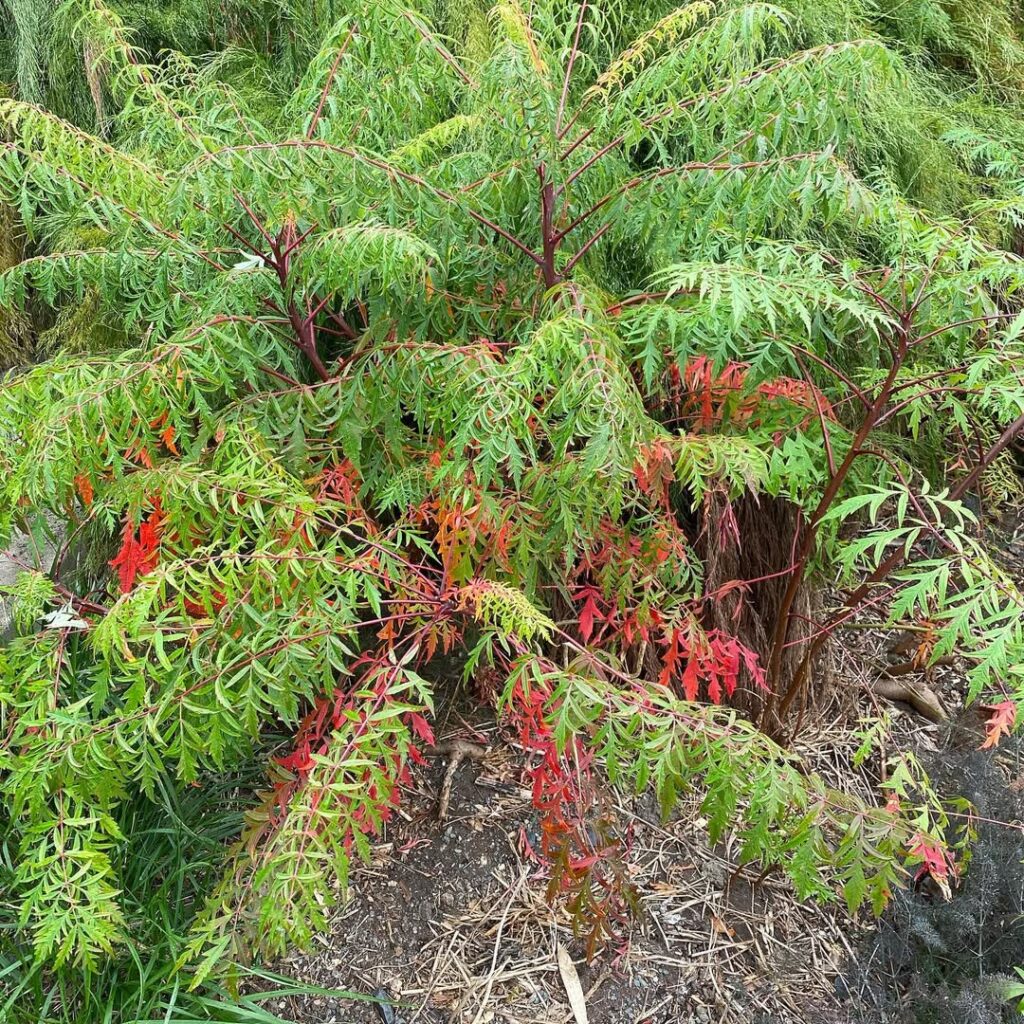
Sumac shrubs are exceptional hardy natives that thrive throughout South Dakota’s challenging climate. These multi-stemmed, colony-forming shrubs offer year-round interest with their distinctive branching structure, brilliant fall foliage in shades of red, orange, and purple, and clusters of red berries that persist through winter. Their ability to spread via root suckers makes them excellent for erosion control and naturalizing large areas.
Beyond their ornamental value, sumacs provide vital ecological benefits by offering food and shelter for wildlife while requiring minimal maintenance once established. Their tolerance for poor soils and drought conditions, combined with their attractive seasonal displays, makes them ideal for native landscaping projects and areas where other plants struggle to survive. Remarkably, sumac is the only shrub species native to all 48 contiguous states, making it one of the most widely distributed native woody plants in North America.
- Hardiness: USDA zones 3-9, extremely cold tolerant
- Light: Full sun to partial shade
- Water: Low to moderate; drought tolerant once established
- Soil: Well-drained, sandy, or rocky soils preferred; tolerates poor soils
- Fertilizer: None required; thrives in nutrient-poor conditions
- Pest/Disease Resistance: Excellent resistance to most pests and diseases
- Growth Rate: Moderate to fast, spreads readily by root suckers
Snowberry Shrub
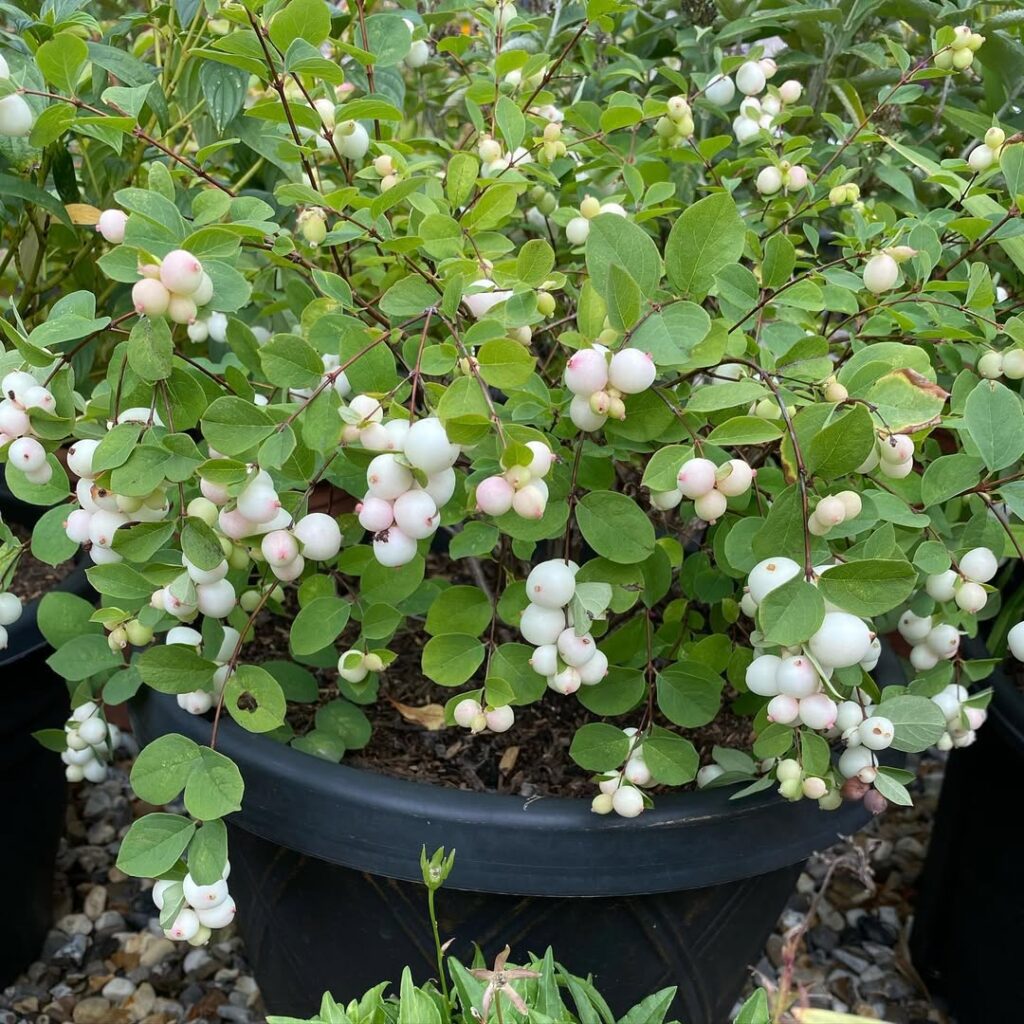
The snowberry shrub is a hardy native deciduous plant that grows 3-6 feet tall with a dense branching structure. This adaptable shrub produces inconspicuous pinkish-white bell-shaped flowers followed by showy white berries that persist through winter. Its rhizomatous root system allows it to form large colonies, making it excellent for natural barriers and thickets.
Native to North America including South Dakota, snowberry thrives in challenging conditions where other plants struggle. It provides significant wildlife value by offering food sources, shelter, and nesting sites for birds and small mammals. The shrub’s ability to spread through underground stems makes it valuable for erosion control and habitat restoration projects. The plant is also deer resistant, making it an excellent choice for areas where deer browsing is problematic.
- Hardiness: Extremely cold hardy, suitable for harsh South Dakota winters
- Light: Full sun to partial shade
- Water: Moderate moisture preferred but drought tolerant once established
- Soil: Adaptable to poor soils, tolerates heavy clay conditions
- Fertilizer: Low maintenance, no regular fertilization required
- Pest/Disease Resistance: Generally pest and disease free
- Growth Rate: Moderate to fast, spreads readily through rhizomes
Selecting the Right Native Plants for Your Garden
When you’re choosing native plants for your South Dakota garden, you’ll want to focus on species that can handle the state’s notorious weather swings and dry spells. Big Bluestem and Little Bluestem grasses form excellent foundations, while Purple Prairie Clover adds vibrant color. Consider your soil type first—most natives adapt to clay or sandy loam conditions.
Group plants with similar water and sunlight needs together for easier garden maintenance. The native plant benefits include reduced watering, fertilizing, and pest control compared to non-natives. Since availability changes monthly based on nursery stock levels, it’s wise to plan your purchases accordingly and sign up for notifications if your desired species are temporarily out of stock. Plant in spring or early fall for best root establishment, then enjoy years of low-maintenance beauty.
Frequently Asked Questions
Where Can I Purchase Native South Dakota Plants Locally?
You’ll find native South Dakota plants at local nurseries like Black Hills Nursery in Rapid City and Big Sioux Nursery. These specialized plant sales offer species adapted to your region’s climate conditions.
When Is the Best Time to Plant Native Species in South Dakota?
Prairie restoration projects succeed when you plant during ideal windows. For best planting times, winter sow native perennials December through February. Seasonal considerations include cold stratification needs and your specific zone’s frost dates.
How Do I Prepare Soil for Native South Dakota Plants?
Start with soil testing to establish pH and nutrient baselines. Remove weeds, rip compacted layers, and guarantee six inches of quality topsoil. Add compost application sparingly since natives prefer natural conditions over heavily amended soils.
Do Native Plants Require Fertilizer or Special Soil Amendments?
Why complicate what nature perfected? You won’t need fertilizers or special amendments for established native plants. They’re adapted to local soils, delivering native plant benefits while maintaining soil health naturally without intervention.
How Long Does It Take for Native Plants to Establish?
You’ll need patience with your establishment timeline, as native plants typically take 2-3 years to fully establish. Their growth rate follows “sleep, creep, leap” – minimal first year, moderate second, substantial third year development.
